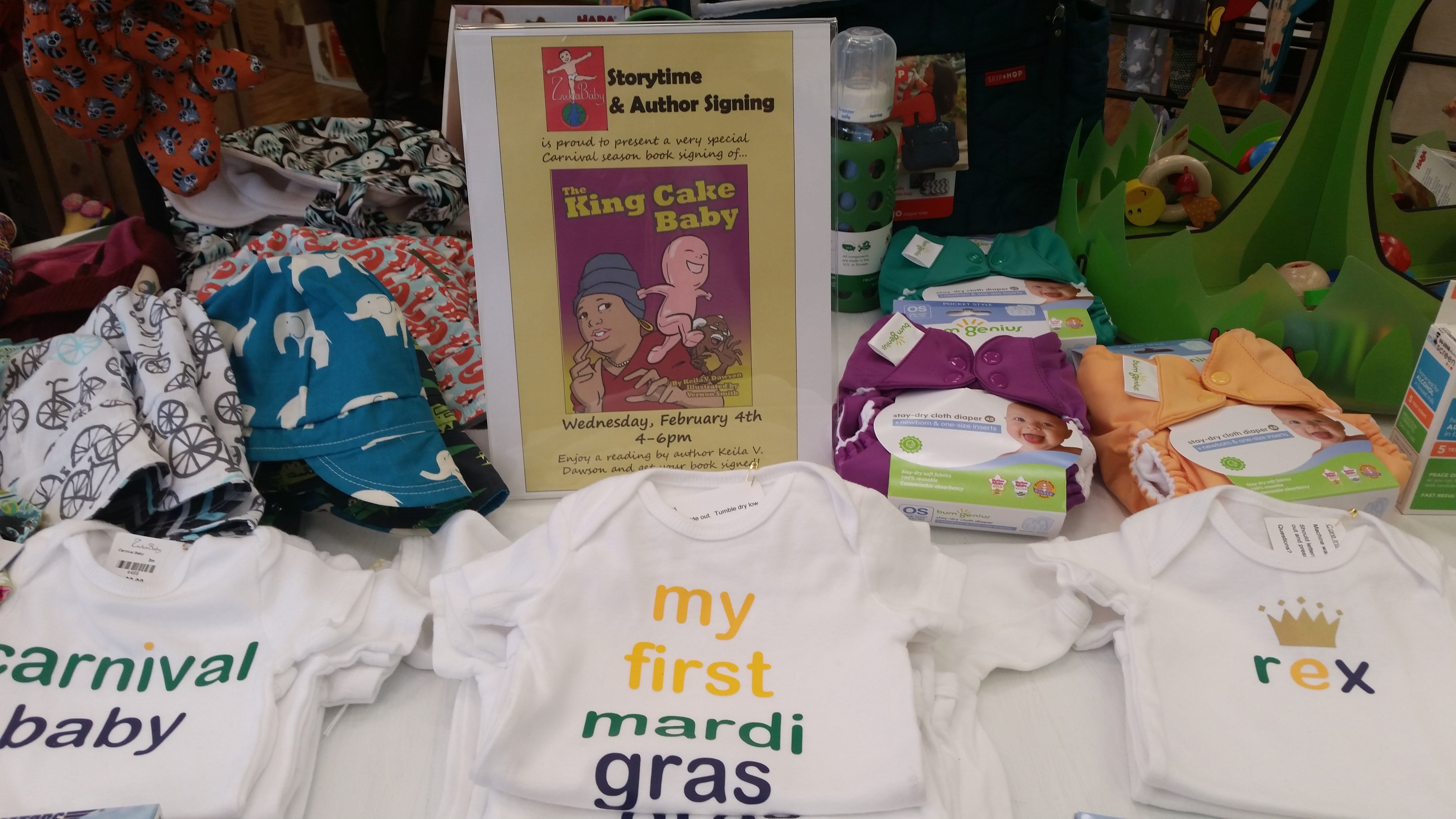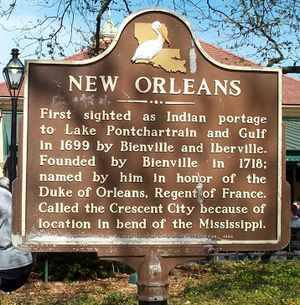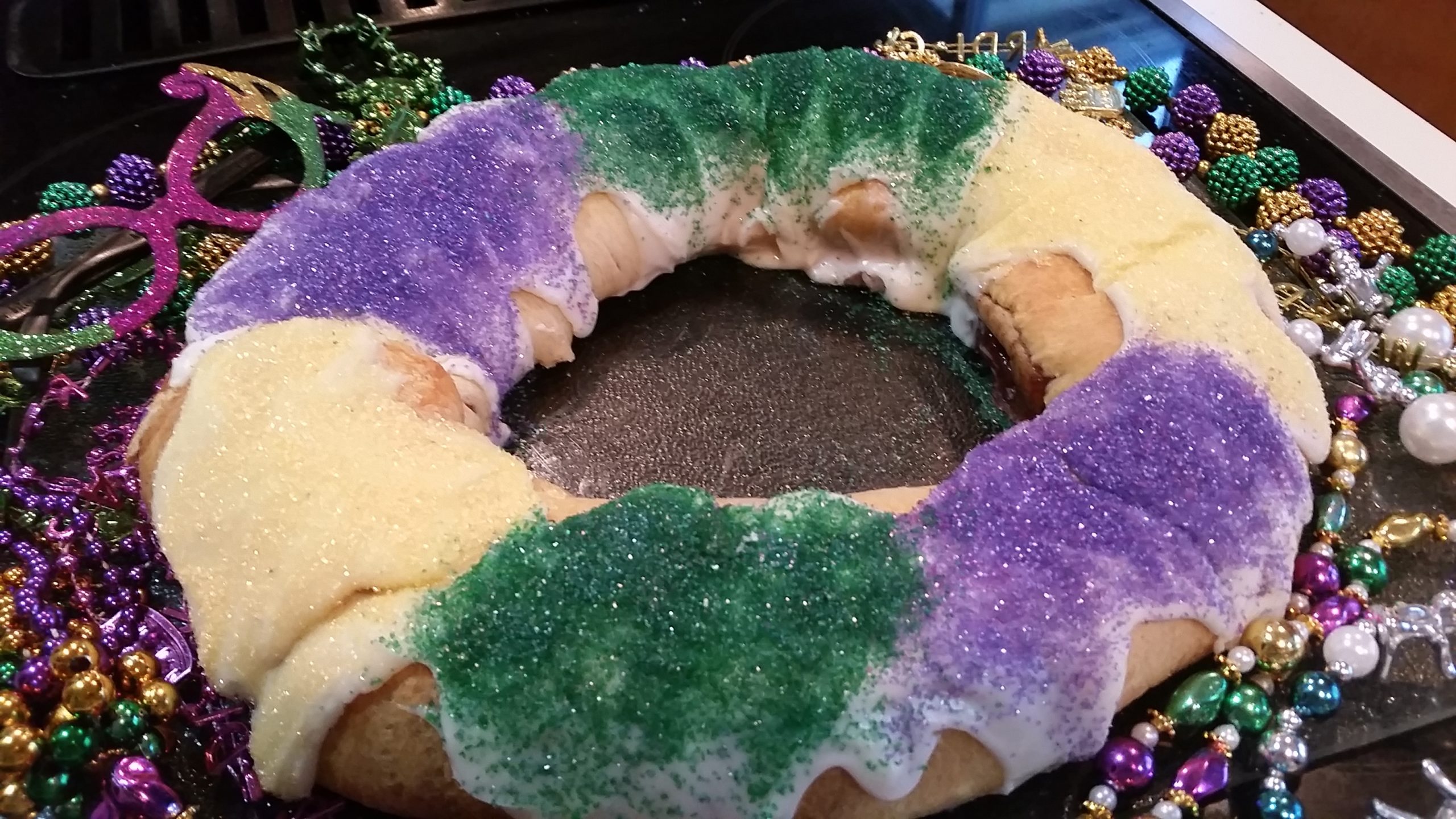ZukaBaby Meet the Author & Illustrator Events at 2122 Magazine, Uptown and 3248 Severn Ave in Metairie.
Thanks for having us, and allowing me to read my debut book The King Cake Baby during story time!
Our baby! Carla, a friend from high school came!
Woodland West Elementary, Harvey, Louisiana, Friday, Februray 6, 2015
Thanks to the teachers, staff, and students at Woodland West Elementary, I had a wonderful visit!





International School of Louisiana , Friday, February 6, 2015
Such a wonderful visit with ISL! Thanks to Laurence Copel, the resource librarian at ISL, I had a wonderful visit!


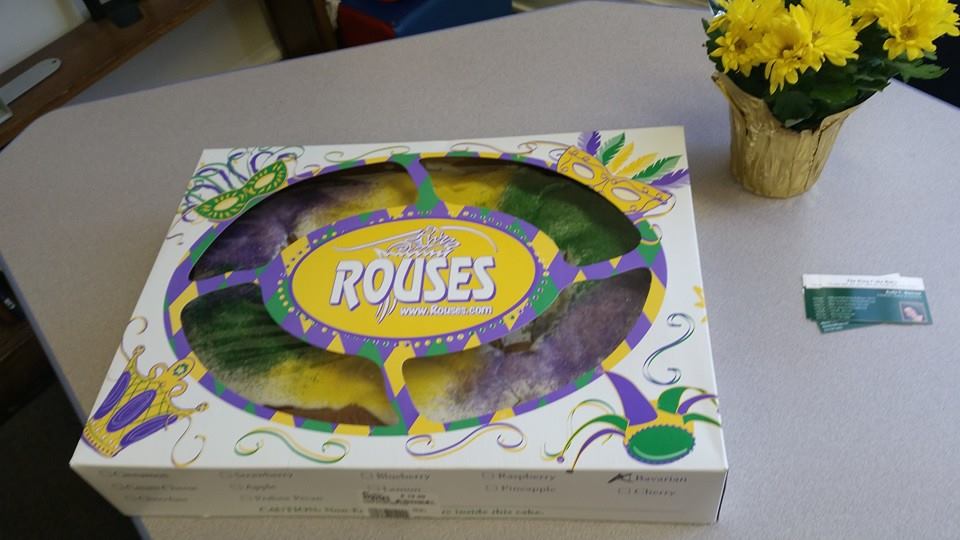
Say what? New Orleans Speak – How to Sound Like A Local
The King Cake Baby picture book is filled with local lingo which includes French vocabulary. Here’s a handy guide if you want to learn more about the language and sound like a local too. Enjoy!
New Orleans: (noo OR-lunz, noo OR-lee-unz, noo AW-linz) a city in the state of Louisiana, former French and Spanish colony.
king cake baby: a small plastic replica of a baby hidden inside a king cake. People want to “get” the baby or find it in their piece of king cake.
king cake: an oval cake decorated in Mardi Gras colors of purple (justice), green (faith), and gold (power).
Kings’ Day: celebrated every January 6th, the first day of the carnival season in Louisiana.
Creole (KREE-ohl) spelled Créole in French. Louisiana Creole is a culture and a language created by people in the colony when multiple old world cultures lived together in the new Louisiana territory during the French, then Spanish colonial periods and continued after the American purchase. Today, the culture is practiced and visible all over south Louisiana through statewide celebrations, use of Louisiana French, Louisiana Creole & Louisiana Spanish languages, architecture, food, music, traditions, festivals, and general joie de vivre.
ma chérie- (mah- SHAY-ree) French word, feminine, used in the English root for the word “cherish”. Means my dear or my darling.
French Quarter: the oldest neighborhood in New Orleans since the founding of the city in 1718. Locals refer to the area as the “Quarter”. The original name is Vieux Carré (VOO cuh-RAY or Vyoo cuh-RAY ) which is French for “old square”.
Mardi Gras: (MAH-dee-graw or MAW-dee-graw) French for Fat Tuesday, the last day of the Carnival season. The length of the Carnival season varies, but always ends the Tuesday before Ash Wednesday, the first day of Lent on the Liturgical calendar of the Catholic Church.
French Quarter cottage: a small, single story creole style home.
mon ami: (mohn a-MEE) French, masculine, means “my friend’’ in English.
praline: (PRAH-leen), a creole candy made with sugar, butter, cream and pecans. A pralinière (prah-leen-YAIR) in French is a woman who sells pralines on the street. Not pronounced “pray-LEEN” in Louisiana.
How you doing dawlin’: (DAW-lyn) a local greeting; example of ”southern drawl” where vowels sounds are prolonged. Omission of the ”r” and final ”g” sounds is also common.
Jackson Square: originally named Place d’ Armes (plahs-DARM) during the French colonial period. The area, renamed Jackson Square after the Battle of New Orleans, showcases an equestrian statue of US President Andrew Jackson.
Come with me by my house: New Orleans local lingo. Means to stop in, not to literally pass by.
Café du Monde: (kah-FAY DOO-mawnd) famous café located in the French Quarter neighborhood known for making the beignet (BEN-yay), a deep-fried French doughnut or fritter.
Where y’at: (yuh-AT) New Orleans local lingo, a traditional greeting and contraction for “you at’’. Y’at is pronounced with 2 syllables.
C’est la vie: (SAY- la-vee) French expression often used in New Orleans, means “such is life” in English.
Creole Queen Riverboat: an authentic paddlewheel riverboat in New Orleans known for Mississippi River cruises, built to mimic the days of Mark Twain.
Yeah, you right: a statement of agreement. Sometimes spoken as one word – YEAH-you-right.
Bon appétit: (BAW na-PAY-tee) French saying, “good appetite’’, means enjoy your meal in English.
Next time – New Orleans street names!
King cake, Mardi Gras, parades, krewes – all traditions unique to New Orleans and Louisiana culture here in the US.
Everyone in Louisiana knows what day it is! It’s Kings’ Day, January 6th, the first day of the Carnival Season!
When people learn I am from New Orleans, they often ask about our Carnival or Mardi Gras traditions. I always include a bit of history about king cake and the tiny plastic baby that is hidden inside. The idea for my upcoming debut picture book, The King Cake Baby, came to me while making a king cake. I couldn’t find a baby and panic ensued. If you don’t have a king cake baby to hide inside, the pastry is just a cinnamon roll!
And I was listening to New Orleans music. So first, here’s a song. Sing along!
Eh là bas! Eh là bas! [Hey over there! Hey over there!]
Eh là bas chérie! [Hey over there, dear.]
Komen ça va? [How’s it going?]
(New Orleans musician Don Vappie on banjo and vocal)
Read on if you’d like to learn more about our traditions. The history of our Carnival and Louisiana king cake practices stem from the periods of colonization as well as English tradition. Combining cake customs from the French and Spanish rulers created the foundation for this Louisiana Creole tradition celebrated on the last day of Christmas also known as Little Christmas, Feast of the Epiphany or Twelfth Night. The beginning of Carnival is always on January 6th and is also known as Kings’ Day. King cakes are baked and eaten throughout this time, known as the pre-Lenten season. Carnival or “carne vale,” means “farewell to the flesh”. Mardi Gras or Fat Tuesday, the day before Lent, is the last day of Carnival. In 2015, Mardi Gras Day is February 17th. Although always a Tuesday, the date varies, therefore the length of the season does too. The number of days during Carnival depends on the liturgical calendar of the Catholic Church. It’s the time between Twelfth Night (in New Orleans, that’s between January 6th and the first day of Lent, Ash Wednesday.) Actually, the date for Easter Sunday sets the length of the Mardi Gras season.
Carnival is celebrated all over the world. And cakes are made too. In France & Québec the cake is called La galette de rois, in Spain and places they colonized like Mexico, South America, Florida, and California the cake is called Rosca de Reyes or ring of kings, in Germany its Dreikonigskuchen, in Scotland, the Black Bun, in Portugal, Bola-Rei. And many more I did not mention. In Louisiana, king cake is a symbol associated with the spirit of Carnival.
Many are surprised to hear that Carnival was not always a mass public daytime celebration in New Orleans. The first Mardi Gras parades were organized in Mobile, Alabama! In 1837, when the people of New Orleans started publicly celebrating in the streets, they were so wild that the government almost banned these celebrations. Yikes! By 1856, the private club or ”krewe” named the Mistick Krewe of Comus from Mobile came to New Orleans to save Mardi Gras. They organized a festive and safe event with floats, masked members who paraded in the street wearing costumes, and hosted masquerade balls .
Credit for the merriment of Mardi Gras seen today in New Orleans goes to the Krewe of Rex dating back to 1872. When Russia’s Grand Duke Alexis Romanoff visited New Orleans, the Krewe of Rex arranged a daytime parade. In 1875 Mardi Gras became a legal state holiday. Decade after decade the celebration grew. More krewes started, bands and throws like beads and doubloons were added to the parades. With the addition of larger krewes and celebrity participation Mardi Gras in New Orleans became an international event.
Louisiana “king cake”, known as kings’ cake or three kings cake in Europe and Latin America, takes its name from Catholic liturgical tradition commemorated on January 6th that celebrates the visit of the Wise Men or three kings to visit the Baby Jesus. The Twelfth Night Revelers, a Carnival society from 1870 chose the “Lord of Misrule” as their king at their ball, following old English tradition. The following year they started the tradition of choosing a queen for his majesty on January 6th. Today that tradition continues, using a “mock” king cake, and the event is considered a kick-off to the Carnival season. King cake eventually became a symbol for the start of the Mardi Gras among locals who were not members of these grand societies. The Krewe of Rex chose the colors associated with Mardi Gras today; purple for justice, green for faith, and gold for power also used to decorate king cakes. In the French tradition, originally a bean or la fève, was hidden inside a king cake. Early on Spain used figurines to represent the Baby Jesus. In Louisiana, pecans and even jewelry were used. However it wasn’t until the 1940’s, that a beloved New Orleans bakery, McKenzie’s, started using the plastic baby we see hidden in king cakes today. In Catholic tradition, the baby represents the Baby Jesus. Whoever gets the baby or whatever is hidden inside is supposed to bring the next king cake or host the next king cake party or could be “crowned” king or queen.
Retail stores love Christmas, florists love Valentine’s Day, chocolatiers love Easter, and Louisiana bakeries love the king cake season! By 1950, the public began buying lots of king cakes. Today, thousands of cakes are eaten and shipped around the world during the Louisiana Mardi Gras season.
And now New Orleans hosts its very own King Cake Festival! The second annual King Cake Festival scheduled for January 25, 2015 is sure to be fun!
Starting today, EAT. KING. CAKE. if you are in New Orleans, join the festival. Plan a trip to see a Mardi Gras parade. Just don’t forget the baby mon ami!
Punxsutawney Phyllis knows that girl groundhogs can do anything boy groundhogs can do. And she proves it to her Uncle Punxsutawney Phil when she is able to make an accurate prediction on Groundhogs Day.
And you know what else Phyllis knows? Girl Groundhogs rule! That’s right, Phyllis went down to New Orleans this month during Carnival, ate a piece of King Cake and got the baby. Now Phyllis is the Queen of the Krewe of Marmotte (that’s groundhog in French)!
You go girl!
Laissez les bon temps roulez!
Punxsutawney Phyllis by Susan Leonard Hill, Illustrated by Jeffrey Ebbeler
In celebration of the first annual Multicultural Children’s Book Day, I choose to highlight Fat Tuesday Mardi Gras La Chatte Noire written by Todd-Michael St. Pierre and illustrated by Diane Millsap. The book is about a cat who lives in Jackson Square in the Vieux Carré (French Quarter) neighborhood of New Orleans. The cat searches for a friend and visits many historical spots in the quarter and around the city. The book is written in English and French. What a lovely tribute to the city of New Orleans!
Happy reading y’all!
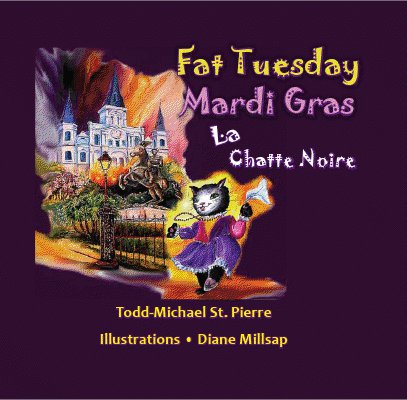
What do you need in the most festive city in the USA? Another festival! The 1st Annual King Cake Festival coming this February. It’s a family friendly festival too. Live performances, kid’s games, stroller fun run and of course a King Cake competition. And it’s FREE.
Wish I could be there with y’all. Have fun! Eat King Cake. AND DON’T FORGET THE BABY! http://www.ochsner.org/king-cake-festival/









